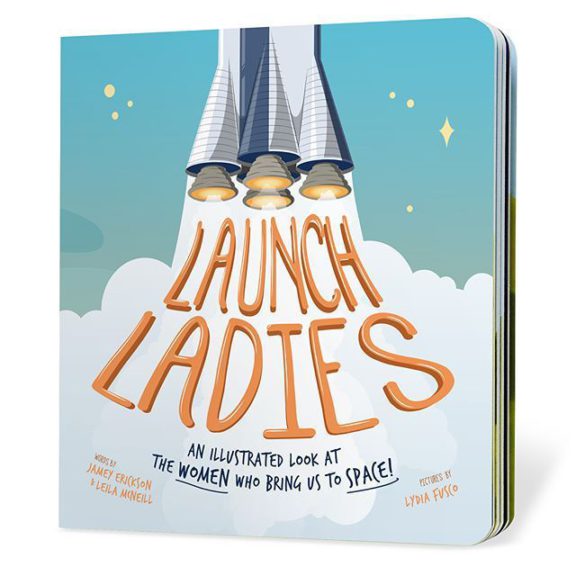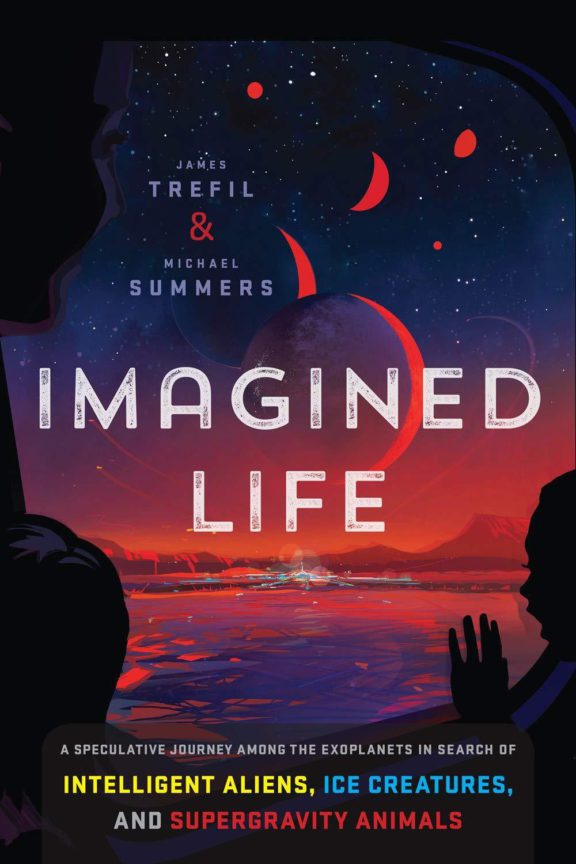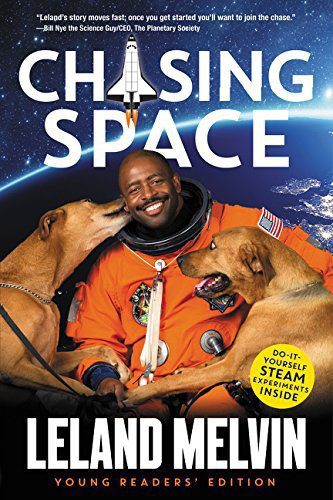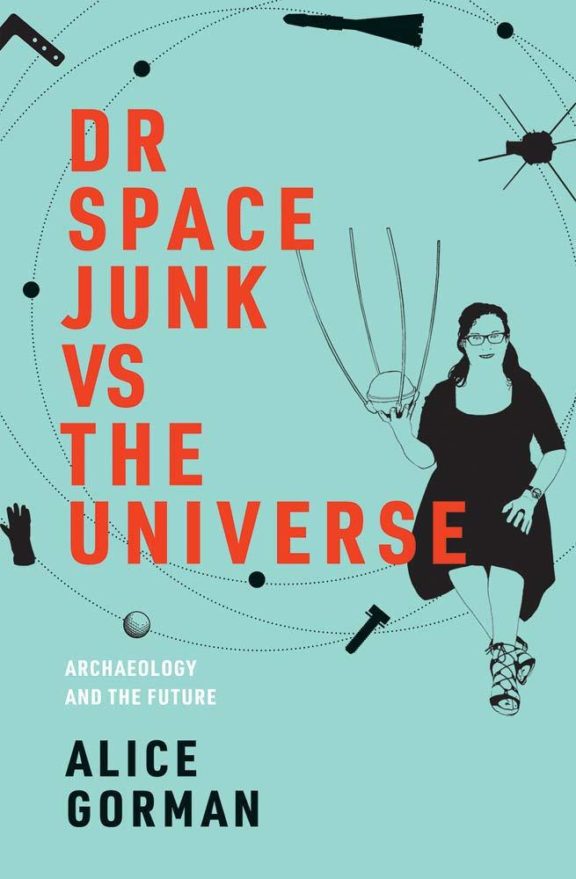Emily Lakdawalla's Recommended Space Books for Kids, 2019

Written by
Emily Lakdawalla
November 13, 2019
Welcome to my 11th annual list of recommended space books for kids! This year I had more than 80 books to read, and I've winnowed the list to recommend 29. It's a fantastic year for read-aloud books and middle-grade biographies, and I have quite a few coffee-table books not explicitly marketed for kids that will fascinate your space-interested teens. If you don't have any kids in your life to buy for, consider donating some to local schools and libraries. Happy reading!
For a collected list of my top recommendations from all years, visit Emily Lakdawalla's Kids' Space Book Recommendations.
Ages 0-3
ABCs of Space
By Chris Ferrie and Julia Kregenow
A good gift for a space fan with a newborn, this book isn’t intended for babies, but it provides parents something interesting and educational to read in colorful board-book format while giving the baby the experience of being read to. Each page covers one letter of the alphabet, from Asteroid to Zenith, and includes a one-sentence definition: “I is for Inflation. Inflation was the very rapid expansion of the universe shortly before the big bang.” Another paragraph with more detailed explanation follows.
Launch Ladies: An Illustrated Look at the Women who Bring Us to Space!
By Jamey Erickson & Leila McNeill, illustrated by Lydia Fusco
Another good gift for parents of a newborn, Launch Ladies features colorful cartoony artworks of Jerrie Cobb, Mary Jackson, Katherine Johnson, Barbara Paulson, Margaret Hamilton, Nancy Roman, Christine Darden, Mae Jemison, Kalpana Chawla, and Marleen Martinez. Each page has a sentence about what they did: “Engineer & mathmetician Mary Jackson calculated flight trajectories on project Mercury!” The content is for the adults, but the pictures and rhythm of a read-aloud book are for the babies in their laps.

8 Little Planets
By Chris Ferrie, illustrated by Lizzy Doyle
A board book with concentric cutouts takes readers from Neptune at the outer edge of the solar system into the Sun, with cute-faced planets, moons, and stars. Each page has two couplets about each planet. The first couplet states a worry the planet feels about its uniqueness — is Uranus’ side tilt weird? Is Mars too dusty? But the second couplet resolves the tension, stating a quality that the planet is proud of: “It’s pretty cool to be the most cold!” for Uranus and “It has the tallest mountain of any planet here!” for Mars. Being able to shift the vocal tone from worry to pride on each page makes it fun to read aloud.
Pop-up Peekaboo! Space
By Dawn Sirett, illustrated by Elle Ward
This pop-up book is super cute. Astronauts Danny and Daisy go on a space journey. Each left-hand page tells part of the story, and the right hand page has a huge flap with a question: “What do they find by the space station?” Open the flap, a space ship flies away from the space station, and a little more of the story is revealed. Pop-up books are not for every kid. However, the pop-up mechanisms in this book series are relatively strong, and they’re activated by opening a huge stiff flap, so it’ll accept more abuse than average. Don’t give this to a kid who’s younger than 2.
Ages 4-7
The Girl Who Named Pluto: The Story of Venetia Burney
By Alice B McGinty, illustrated by Elizabeth Haidle
This lovely book explains how a little girl’s love of mythology and asking questions inspired her to suggest the perfect name for Pluto, and how family connections helped deliver her suggestion to the Royal Astronomical Society and ultimately Clyde Tombaugh. It is mostly based on true events and ends with the story of an elderly Venetia Burney Phair seeing Pluto through the eyepiece of a telescope for the first time. It’s a gentle story, told in present tense, the language enjoyable to read aloud.

Always Looking Up: Nancy Grace Roman, Astronomer
By Laura Gehl, illustrated by Louise Pigott and Alex Oxton
Always Looking Up is an excellent biography of an excellent woman. Roman was remarkable for overcoming sexism to become an astronomer and for her pioneering research, for starters. However, as the book makes clear, her greatest accomplishments were in the realm of service to the astronomy community, and I don’t believe I’ve read a children’s book about that before. It talks about her traveling to the Soviet Union for scientific exchange during the Cold War, about becoming the chief of astronomy at NASA, and of course, about her role as the mother of the Hubble Space Telescope. “Nancy Grace’s passion shone as she spoke,” Gehl writes. “She had seen and learned so much in her career already. Now she could share that knowledge with others.”

Twinkle Twinkle Little Star: I Know Exactly What You Are
By Julia Kregenow, illustrated by Carmen Saldaña
“Opaque ball of hot dense gas, million times our planet’s mass, looking small because you’re far, I know exactly what you are.” I set a high bar for “Twinkle, twinkle” poetry: it needs to toe the line on meter, not squeezing in awkward extra syllables or torturing grammar. I’m happy to say that this book meets that bar and is delightful to read aloud. It teaches about different types of stars and goes on to black holes and galaxies before returning home.

The Astronaut Who Painted the Moon: The True Story of Alan Bean
By Dean Robbins, illustrated by Sean Rubin
Alan Bean was a pilot, an astronaut, a scientist, and an artist, all at once. The book talks about how Bean saw the lunar surface through an artist's eyes, and how he sought to use art to communicate the feeling of being on the Moon. How he approached his art both scientifically (building and lighting models to get shadows right) and imaginatively (employing colors and materials that weren't exactly real, but evoked how space made him feel). The text is spare and rhythmic blank verse, a delight to read aloud. I'm keeping this one to take to school and library visits!
The First Men Who Went to the Moon
By Rhonda Gowler Greene, illustrated by Scott Brundage
The most beautifully illustrated book in my Apollo stack, filled with stark paintings simultaneously rich with accurate detail and evocative of drama and desolation. The book builds up to a dramatic shift at the middle of the story, from active exploration to return and reflection on what the astronauts left behind, from a more complicated rhythmic structure to more simple rhyming couplets "there in the Sea of Tranquility / where the astronauts made history...." I think this could be a good read-aloud book and the paintings are fantastic, but I'd need to practice it a few times to perform it well.
Moon's First Friends
By Susanna Leonard Hull, illustrated by Elisa Paganelli
Poor Moon keeps inviting the denizens of Earth to visit her, but neither the dinosaurs, nor the mammoths, nor the neanderthals, nor pyramid-builders, nor Montgolfiere-flyers ever seem to notice her. She even tries completely blocking out the Sun at high noon, and no one comes! Of course, we know how this ends. It's a cute story and manages to deliver some facts (including how solar eclipses work!) seamlessly within the narrative. But the last page of the story might make Apollo fans sigh: "And now she had hope that it would happen again...and again."
Sadiq and the Desert Star
By Siman Nuurali, illustrated by Anjan Sarkar
In this easy chapter book with friendly cartoony illustrations, a Minnesotan boy falls in love with astronomy on a field trip to a planetarium. He and some of his classmates establish a school Space Club then and there. Unable to afford a telescope, they learn how to make one, work to raise money at a school fair, and are rewarded with a view of stars and planets through the telescope they built. In and out of the story are woven references to the boy’s Somali culture; his father tells stories of caravans navigating by the stars, and his mother and sister make and sell sambuus (samosas) for the bake sale. At the end of the book are instructions for making the telescope described in the story. There are 3 other books in the Sadiq series.
Pluto Gets the Call
By Adam Rex, illustrated by Laurie Keller
Back when New Horizons flew past Pluto, I had the idea to write an educational children’s story from Pluto’s point of view about how Pluto felt upon “demotion” and then found a place to belong among the wonderful new worlds of the Kuiper belt. It turns out I wasn’t the only one with this idea; I had no fewer than four books on this theme to review this year. I have two to recommend. The first is Pluto Gets the Call. It’s very funny with distinct voices for each of the planets, and has really engaging illustrations, but still educational. At the end, the Sun tells Pluto about how much everyone loves him and relates to him for being the underdog, which is pretty cute.
All My Friends Are Planets: The Story of Pluto
By Alisha Vimawala, illustrated by Troy Nelson
Another book on the theme of Pluto’s reaction to the change in its planetary status, but very different from Pluto Gets the Call. All My Friends Are Planets begins with a solar system tour but takes a turn in the middle when Pluto says: “I felt so alone. Everything that once made me unique now became a reason to exclude me. Was I really that different? Was there anyone else like me?” At the end, Pluto finds a place to belong among the dwarf planets, “And together we make the solar system larger and friendlier.” To an adult reader, it’s a blatant metaphor for the kinds of isolation children can experience due to different gender identity, disability status, or other difference, and for found family. It could be a useful book to initiate conversations with kids who feel that they are different — or kids who could use a story to develop compassion for others.
To the Moon!
By Jodie Shepherd, illustrated by Mike Byrne
One of a series of 5 books with the same plot: A child’s mind wanders in school, and they go on an imagined journey to another place in the solar system. The other four destinations are the Sun, the stars, Earth, and Mars. Along with the story, each two-page spread has a fact about the world or its exploration. To me, the educational component of these books is less important than the way they encourage kids to imagine themselves traveling to other, real worlds.
Ages 8-10
Scratching the Surface: Generation Mars, Prelude
By Douglas Meredith, illustrated by Luis Peres
I’m usually hesitant to accept self-published novels for review, but Scratching the Surface is a rare well-told, well-edited story that proves the rule. It’s a genial story for readers new to chapter books about the first children on Mars and their first school field trip from their underground habitat to the Martian surface, involving their first exhilarating view of an open sky. And there’s a few poignant moments that will hit readers’ parents harder. The details of the habitat, its life-support systems, and surface suits are rooted in realistic science and technology, with further details explained in a postscript to the book. To top it off, Peres’ illustrations are gorgeous. I’m looking forward to further installments in the series!
The Space Race: The Journey to the Moon and Beyond
by Sarah Cruddas (foreword by Eileen Collins)
This book is a whole history of space exploration, focusing primarily on human spaceflight, excellently illustrated, brightly designed, and engagingly written, with well-chosen topics on each two-page spread. The first half of the book focuses on early human spaceflight through Apollo-Soyuz, including features on rocket designers, human computers, and pop culture, and the second half proceeds forward through Shuttle and ISS to modern developments (SpaceX, Blue Origin, and plans for humans to Mars and asteroid mining). As a bonus, the cover is very shiny and tactile, with a brilliant metallic finish. A terrific gift book for a confident young reader and a really good introduction to human spaceflight for parents who haven't paid much attention before their kid's enthusiasm forced them to.
Moon Landings
By Shoshana Weider
A well-illustrated narrative history of the Apollo program, written by a real live planetary geologist. It begins with a short chapter on the early development of space exploration and devotes one chapter each to Apollo 7-10, Apollo 11, and Apollo 12-17 plus a brief mention of recent international robotic lunar missions. The small amount of space given to the latter Apollo missions prevents the inclusion of much of anything about what the program accomplished besides putting boots on the ground and bringing back rocks, but it's an accessible history for a kid transitioning from picture books to chapter books.
Planet Hunting: Racking Up Data and Looking for Life
By Andrew Langley
An excellent and up-to-date book on exoplanets and how we discover them. Planet Hunting begins with an explanation of exoplanets and describes in age-appropriate detail how the transit method, “wobble method” (radial velocity method), and direct imaging work. It describes the weird kinds of planets we’ve found (including “gas dwarfs,” their term for sub-Neptune and super-Earth, which I rather like), and discusses Hubble, TESS, Gaia, WFIRST, and JWST. Glossary definitions on the same pages that challenging words appear are very helpful. This book is part of a Future Space series from Capstone but it’s my favorite of the lot.
Ages 11-13 (Middle Grade)
Many of the books that I recommend for this age range are suitable for young adults as well.
Constellations: The Story of Space Told Through the 88 Known Star Patterns in the Night Sky
By Govert Schilling with original star maps by Wil Tirion
This is exactly the kind of book I would have loved as a science-obsessed kid. It’s not a kids’ book, but it’s written by a skilled science journalist and is highly accessible. It is filled with facts and gorgeously designed. It can be dipped into at random, or read cover-to-cover. The introductory information on the history of the constellations is thorough without being overlong. And did I mention how absolutely stuffed with factual information it is? For each constellation there’s a detailed map and a table with information about the number of stars it contains, bordering constellations, and when it’s visible to skywatchers, at what latitudes. There’s a timeline of discoveries associated with the constellation, reproductions of classical representations of the constellation, a handful of lovely photos of sky phenomena within them, and/or an artist’s representation of an exoplanet found within it. Each photo has a short but detailed and informative caption right next to it, making the book easy to navigate. One thing I especially appreciate about the captions is how Schilling usually identifies the facility used to take the photo and whether it’s in natural color or some other wavelength, a rarity in popular books about space.

Visual Galaxy: The Ultimate Guide to the Milky Way and Beyond
By National Geographic with a foreword by Chris Hadfield
Visual Galaxy is an encyclopedic book, containing a lot more than I expected from its title. Only about a third of the book is devoted to the Milky Way and the stars and structures within it; almost all of the rest of the book is devoted to our own solar system and is a surprisingly good introduction to solar and planetary science. It contains beautiful photos and illustrations as one would expect from a National Geographic publication. In addition to that, it has excellent infographics on everything from the optical density of Saturn’s rings to the composition of planetary atmospheres to the warping of the Milky Way disk. Like Constellations, it can be dipped into at any point, or read cover-to-cover, and offers plenty of opportunity for learning whether you’re a kid space fan or a seasoned expert.

TV Brings the Moon Landing to Earth
By Rebecca Rissman
A look at Apollo 11 through the lens of the television-viewing audience, TV Brings the Moon Landing to Earth talks about the technology that enabled Apollo video to reach Earth, the cultural context in which that video arrived, and its impacts on society. It includes plenty of detail about the operation of the mission, but is unique among Apollo 11 books I’ve read this year (and there have been many) for its explication of how most people on Earth would’ve experienced the landing in real time. This book is part of a series called Captured Television History; there’s another space-related one on the Challenger disaster.
Galaxy Girls: 50 Amazing Stories of Women in Space
By Libby Jackson, illustrated by students from the London College of Communication
I just love this book. Each two-page spread contains a detailed biographical essay on a woman involved in space or aviation history, paired with a colorful illustration; the illustrations have a variety of styles, from representational to nearly abstract. I had not heard of maybe half of the women profiled, and they represent a fascinating variety of contributions, from software engineers to space lawyers. My only criticism is that there are not a lot of space scientists — the book is very focused on human exploration, with about a third of the listed women being astronauts. But that’s perhaps a biased quibble; it’s an easy-to-read and enjoyable book for kids age 10 to 18, I think.

Chasing Space: Young Readers’ Edition
By Leland Melvin
Astronaut and former professional football player Leland Melvin’s autobiography is a powerful story of overcoming adversity over and over again, helped along by his own grit, the support of family and friends, and, often, luck. Every chapter seems to contain a story in which his future balanced on a knife edge between excellence and failure, sometimes because of his own mistakes, other times just bad luck, and quite a few caused by blatant racism. Even though Melvin tells his story matter-of-factly, it’s gripping reading. My favorite aspect is how it’s bursting with love, gratitude, and admiration for the family, friends, and professional colleagues who helped him along the way.
Reaching for the Moon: The Autobiography of NASA Mathematician Katherine Johnson
By Katherine Johnson
You’re no better than anybody else, but nobody’s better than you. Katherine Johnson repeats her father Joshua Coleman’s words as a mantra throughout this excellent book. She sets her personal story in context with details about the cultural and political history of Jim Crow and the civil rights era, discussing how encounters with people who had control over her future often hinged on race. Her story is one of talent, hard work, patience, and determination. Her successes often came by being stubbornly competent and refusing to be discouraged until the people around her grudgingly recognized that they needed her skill. For example, she was brought into the Flight Research Division of NACA to analyze data from one flight test, and was expected to be returned to the computing pool afterwards, but, she writes: “Somehow the engineers ‘forgot’ to return me. Instead they just handed me the next set of calculations—and then the next. Then the next. Then the next. That’s when I realized that they needed me, Colored or a woman or not. And suddenly I found myself a research mathematician!”

Ages 14-18 (Young Adult)
These books are not specifically marketed for teens, but they have my seal of approval for being accessible to space-interested teen readers. Also consider for this age group some of the ones I put into the middle-grade category.
Imagined Life: A Speculative Scientific Journey among the Exoplanets in Search of Intelligent Aliens, Ice Creatures, and Supergravity Animals
By James Trefil and Michael Summers
Is there life elsewhere in the universe? Is it made of the same stuff as us, on an Earthlike world, or does it have different chemistry on a different kind of planet? These are fascinating questions for any space fan, but they are also frustrating, because we have so little data. At best, we can imagine what might be out there, either thought experiments firmly based in known physics or speculative fiction or some combination of the two. At the outset, Trefil and Summers’ book is an excellent introduction to the basic ideas of the study of astrobiology, explaining what experiments have shown us so far, what scientists are searching for, and the underlying physics and chemistry. The language is very accessible, always emphasizing the questions scientists are asking, how we’ve discovered answers, and how much we still don’t know. When the authors run out of facts and data—and that doesn’t take long, this is astrobiology we’re talking about—it turns speculative, considering several different kinds of exoplanetary environments where life might arise, and the reasons why (or why not) intelligent life could result. I would especially recommend this book to any kid (or adult) who enjoys writing hard science fiction, as inspiration for imagining alien life.

Light from the Void
By Kimberly Arcand, Grant Tremblay, Megan Watzke, Martin C. Weisskopf, and Belinda J. Wilkes, with an introduction by Eileen Collins
The Chandra X-Ray Observatory is (along with Hubble, Compton, and Spitzer) one of NASA’s Great Observatories, enormous space telescopes that have revolutionized astronomy in part by enabling study of stars and galaxies in wavelengths that don’t penetrate Earth’s atmosphere. Hubble is the best known for its stunning photos, but Light from the Void proves that enhancing Hubble imagery with X-ray data from Chandra attains a whole new dimension of beauty. The book has short introductory essays followed by edge-to-edge prints of gorgeous astronomical objects, each one paired with a detailed caption explaining the significance. I especially appreciate how every caption includes information on the scale of the view, the distance to the object, and the wavelengths of light used to compose the image. The beautiful images are the main point of this coffee-table book, but there is plenty to learn from the text.

Launch Photography: Ben Cooper Photographs Rockets of NASA and More
By Ben Cooper
Is your kid a rocket fan? Ben Cooper is one of the best launch photographers out there, and he’s compiled a huge portfolio of his work in this book. Many of the 120 pages contain multiple photos, each with a chatty caption. Cooper pairs information about the rockets and spacecraft with anecdotes about the launch day and photography conditions. About two thirds of the book chronicles the final years and end of the Shuttle program, which Cooper photographed for NASA from 2008 until its end in 2011; the remainder is rocket launch eye candy, including quite a few inspiring photos of the first landings of the Falcon first stages.
Urban Legends from Space: The Biggest Myths About Space Demystified
By Bob King
Space fans like me have to spend a lot of time straightening out misconceptions and debunking conspiracy theories. It’s hard to do this well because people who hold these misconceptions or have heard of these theories are often really excited about space, and I don’t want to dampen their enthusiasm, just gently guide it closer to reality. Bob King has written a really useful resource for any space fan whose friends and family think that the Moon has a dark side, or that moon phases are caused by Earth’s shadow, or who have heard that an asteroid is going to hit us, or who have stumbled across electric-universe videos on YouTube, or who believe that the joke about NASA developing space pens while cosmonauts used pencils is a true story. King patiently explains what’s actually going on in about 50 different myths and legends of space exploration, countering confusion with knowledge in short, rich chapters.
Dr Space Junk vs The Universe: Archaeology and the Future
By Alice Gorman
This is a marvelous book that examines humanity's exploration of space in its full cultural context, as recorded in the artifacts left behind both on Earth and elsewhere. Gorman developed as an archaeologist in the Australian outback, where she studied some of the most ancient artifacts of human culture at the same time that she was constantly stumbling across modern trash associated with the Space Age. With a light and conversational voice, she delivers piercing insights into the meaning of our various efforts to leave Earth behind, as well as an entertaining primer on how archaeologists work and what they can teach us. It’s a delightful read and a wonderful example of how enriching it can be to cross academic disciplines.
Breakthrough research starts with YOU!
Your support will empower the next round of STEP grant winners. Make your gift today to fund tomorrow's promising science and technology projects.
Donate

 Explore Worlds
Explore Worlds Find Life
Find Life Defend Earth
Defend Earth




















